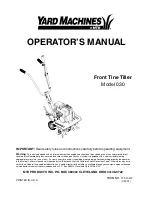
RLC-SVX14H-GB
27
Condenser water inlet and outlet types, sizes and
locations are given in the Unit Dimensions and Weights.
Condenser pressure drops are shown in Figure 6.
Condenser Piping Components
Condenser piping components and layout vary,
depending on the location of connections and the
water source. Condenser piping components generally
function identically to those in the evaporator piping
system, as described in “Evaporator Piping”. In addition,
cooling tower systems should include a manual or
automatic bypass valve that can alter the water fl ow
rate, to maintain condensing pressure. Well water
(or city water) condensing systems should include a
pressure reducing valve and a water regulating valve.
Pressure reducing valve should be installed to reduce
water pressure entering the condenser. This is required
only if the water pressure exceeds 10 bar. This is
necessary to prevent damage to the disc and seat of the
water regulating valve that can be caused by excessive
pressure drop through the valve and also due to the
design of the condenser. The condenser waterside is
rated at 10 bar.
CAUTION Equipment Damage!
To prevent damage to the condenser or regulating
valve, the condenser water pressure should not exceed
10 bar. The optional water regulating valve maintains
condensing pressure and temperature by throttling
water fl ow leaving the condenser in response to
compressor discharge pressure. Adjust the regulating
valve for proper operation during unit start-up. Refer to
RLC-PRB021-EN for further details regarding condenser
water temperature control.
Note: Plugged tees are installed to provide access for
chemical cleaning of the condenser tubes. Condenser
piping must be in accordance with all applicable local
and national codes.
Condenser Drains
The condenser shells can be drained by removing the
drain plugs from the bottom of the condenser heads.
Also, remove the vent plugs at the top of the condenser
heads to facilitate complete drainage. When the unit
is shipped, the drain plugs are removed from the
condenser and placed in a plastic bag in the control
panel, along with the evaporator drain plug. The
condenser drains may be connected to suitable drains to
permit drainage during unit servicing. If they are not, the
drain plugs must be installed.
CAUTION! In case of low evaporator leaving water
temperature applications, the non use of glycol on the
condenser side may result in condenser tube freeze-up.
Water Regulating Valve
Water Treatment
Using untreated or improperly treated water in these
units may result in ineffi cient operation and possible
tube damage. Consult a qualifi ed water treatment
specialist to determine whether treatment is needed.
The following disclamatory label is provided on each
RTWD unit:
CAUTION Proper Water Treatment! The use of untreated
or improperly treated water in a Chiller may result
in scaling, erosion, corrosion, algae or slime. It is
recommended that the services of a qualifi ed water
treatment specialist be engaged to determine what
water treatment, if any, is required. Trane assumes no
responsibility for equipment failures which result from
untreated or improperly treated water, or saline or
brackish water.
For leaving chilled water temperatures below 3.3°C, it
is mandatory to operate the unit with the appropriate
freeze inhibitor (glycol type and percentage) in both
evaporator and condenser water loops.
Water Pressure Gauges
Install fi eld-supplied pressure gauges (with manifolds,
whenever practical) on the RTWD units. Locate pressure
gauges or taps in a straight run of pipe; avoid placement
near elbows, etc. Be sure to install the gauges at the
same elevation. To read manifolded pressure gauges,
open one valve and close the other (depending upon the
reading desired). This eliminates errors resulting from
differently calibrated gauges installed at unmatched
elevations.
Water Pressure Relief Valves
Install a water pressure relief valve in the condenser and
evaporator leaving chilled water piping. Water vessels
with close coupled shutoff valves have a high potential
for hydrostatic pressure buildup on a water temperature
increase. Refer to applicable codes for relief valve
installation guidelines.
CAUTION Prevent Shell Damage!
To prevent shell damage, install pressure relief valves in
both the evaporator and condenser water systems.
Condenser Piping
Содержание RTUD
Страница 78: ...RLC SVX14H GB 78 RTWD Operating map...
















































